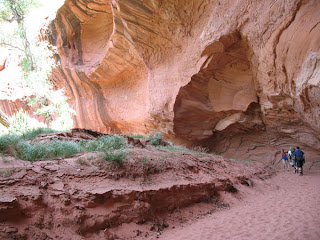Utah Backcountry Volunteers - Escalante River Trip Report
 This trip report is from Utah Backcountry Volunteers which is a new non-profit organization that Backcountry.com has created a partnership with. This is from a trip to the Glen Canyon National Recreation Area, Escalante River removing Russian Olive trees - April 29-May 5
This trip report is from Utah Backcountry Volunteers which is a new non-profit organization that Backcountry.com has created a partnership with. This is from a trip to the Glen Canyon National Recreation Area, Escalante River removing Russian Olive trees - April 29-May 5Our adventure began by strapping on one-week backpacks and leaving cars behind at the Egypt Trailhead in the Glen Canyon National Recreation Area. The group of 8 volunteers from all over the country, led by intrepid Park Ranger Bill Wolverton, descended 6 miles across steep slickrock slopes and pinion/juniper flats to drop
 into the lush, oasis-like Escalante River bottom just upstream of Twenty-Five Mile Wash. Camp was quickly established on the rim of a sagebrush flat 150’ directly above the river, with short rock-hopping access for daily water jug re-fills...and for the as-needed, invigorating dip and rinse!
into the lush, oasis-like Escalante River bottom just upstream of Twenty-Five Mile Wash. Camp was quickly established on the rim of a sagebrush flat 150’ directly above the river, with short rock-hopping access for daily water jug re-fills...and for the as-needed, invigorating dip and rinse!Our service project was removal of invasive Russian olive trees with hand tools such as a pruning saw, loppers, pulaski, and an herbicide to treat cut stumps. Non-native, decorative Russian olive trees have escaped backyards and city parks because their seeds successfully float downstream through Utah’s rivers & other waterways, embedding in banks and out-competing native young riparian trees such as Cottonwoods. Small Cottonwoods can’t succeed the tall, mature trees that typify many Utah rivers, however, cutting mature Russian olive prevents their seed production and they can be eradicated, swinging natural systems back into place.
This spring the work was particularly slow due to a huge flood that scoured the entire canyon in 25’ of water last October. Although the mature Russian olive trees are pretty easy to spot from a distance and to trim and cut, flood debris made our task arduous, yet in the end more satisfying. In four work days (Mon, Tues, Thurs, Fri) our group cleared approximately 1 full mile of the river bottom of these non-natives that are out-competing young, native Cottonwood and other desert riparian trees.
 Although we donated 256 hours in total, ours was but one group assisting the National Park Service in this ongoing project now in its 8th season, and sure to continue several more years.
Although we donated 256 hours in total, ours was but one group assisting the National Park Service in this ongoing project now in its 8th season, and sure to continue several more years.Of course it’s not all-work-and-no-play with Utah Backcountry Volunteers. Our Wednesday group day-hike took us on a cross-country excursion to the breathtaking Neon Canyon. This red rock side canyon of the Escalante is a mellow stroll up a deep, cool, sandy wash culminating in a huge pool at the base of a 75’ sculpted, magnificent slickrock water fall. The unique beauty of this place becomes apparent upon making water ripple patterns that are reflected onto the striped sandstone bowl. As we leisurely made our way back to camp walking through the calf-deep Escalante River, we realized we were in a very special place, on a trip to be remembered. As one volunteer put it “Thanks for a superb trip! I hope to go with you again.”

 Get involved by volunteering and get into the backcounty on one of their fall service trips. Check UtahBackcountry.org for dates and locations.
Get involved by volunteering and get into the backcounty on one of their fall service trips. Check UtahBackcountry.org for dates and locations.Labels: Adventure Report, Backcountry.com
2 comments






2 Comments:
Now if we could only get rid of all the invading tamarisk trees, it might get back to normal down there.
6/21/2007 1:01 PM
Isn't that the truth! I took a canoe trip on the Green River through Laybrith Canyon in 1983 as a boy scout and just before a place called Bow-Knot-Bend there was a great little cove that we pulled off into and then hiked up onto the bluff above the river where we camped. The cove easily fit the 8-9 canoes we had in our group. It was the best camp spot we had all week.
In 1998 I went back down that section of the river and when we tried to pull into that cove it was impassable, over-run by tamarisk trees. We had to move along and make a sketchy landing where the current was faster and the slope rocky and dangerous. Tamarisk trees are the scourge of the SouthWest.
6/21/2007 5:59 PM
Post a Comment
<< Home